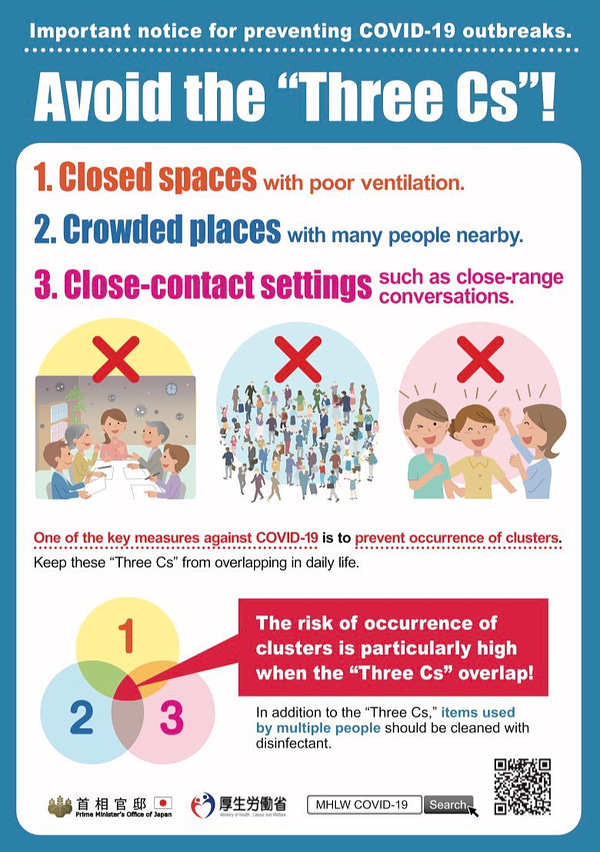🦠 COVID-19 | The public has been outstanding, the leaders less so
I am a scientist by education, banker at JPMorgan for a few years, then mature PhD student in Chemical Biology at Oxford under the supervision of Christofer Schofield (FRS) and Peter Ratcliffe (Nobel laureate in medicine in 2019). Founder and tech investor focusing on media and education. I care about science, learning and Democracy which are good bedfellows.
📊 Daily Data Brief: (❗️48 hours period +/-)
Cumulative case: 5,582,370 (+193,190) cumulative cases
Active cases: 2,873,764 (+23,683) (this is the number of currently infected patients)
Total Deaths: 347,563 (+4,103)
Serious/Critical Cases: 53,167 (-369)
Recovered: 2,361,041 (+124,402)
Source: Worldometers
1) Seven-day rolling average of new deaths (updated daily as ECDC releases). Major update with per country graphs now available (Link) (US, UK, France, Germany, Sweden, Nordic Comparison)
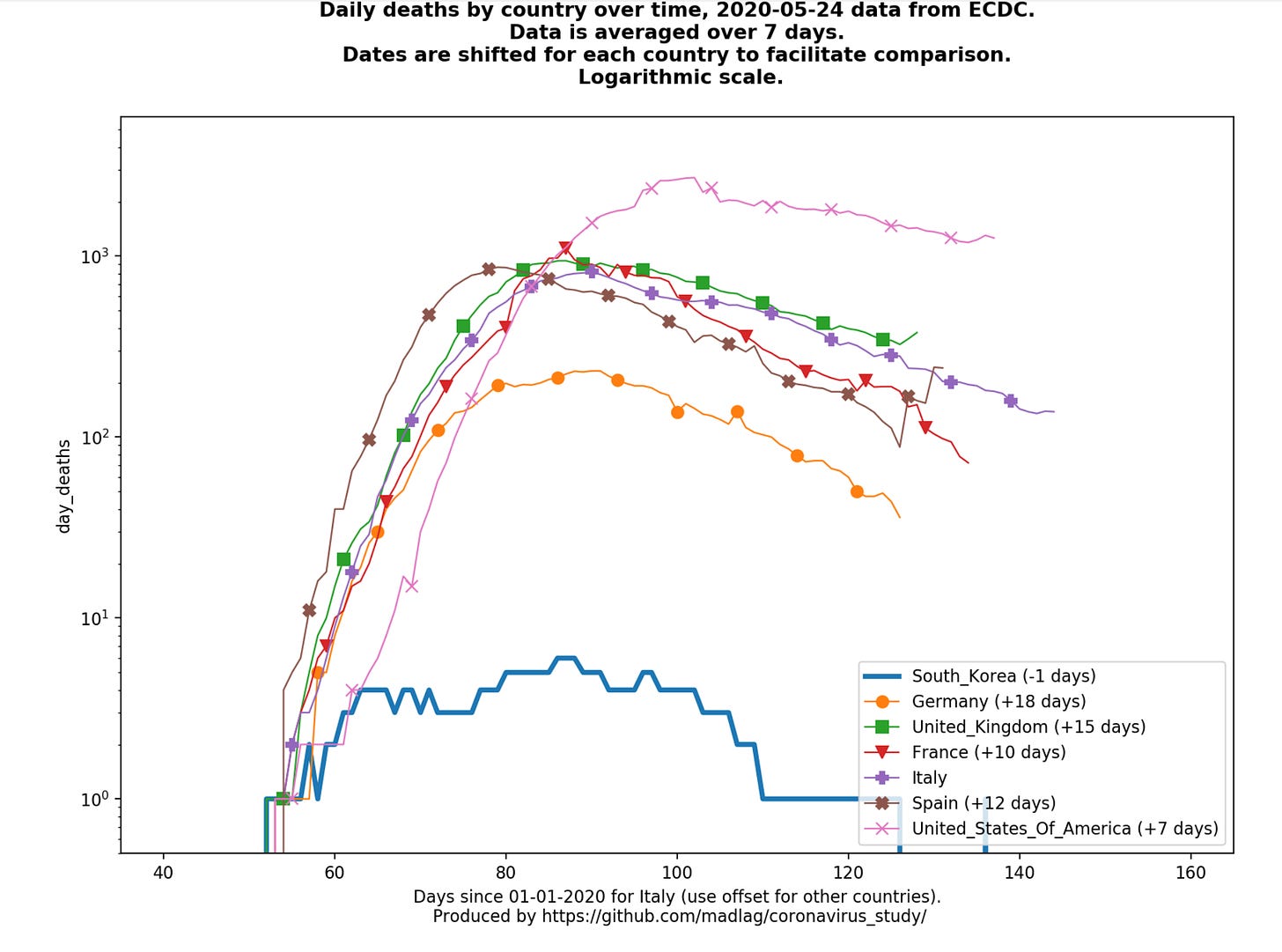
Showing a chart from the FT today highlighting the worrying situation in Brazil, Mexico, India and Russia. Also the FT comparative charts now allow up to 6 countries (NEW❗️)
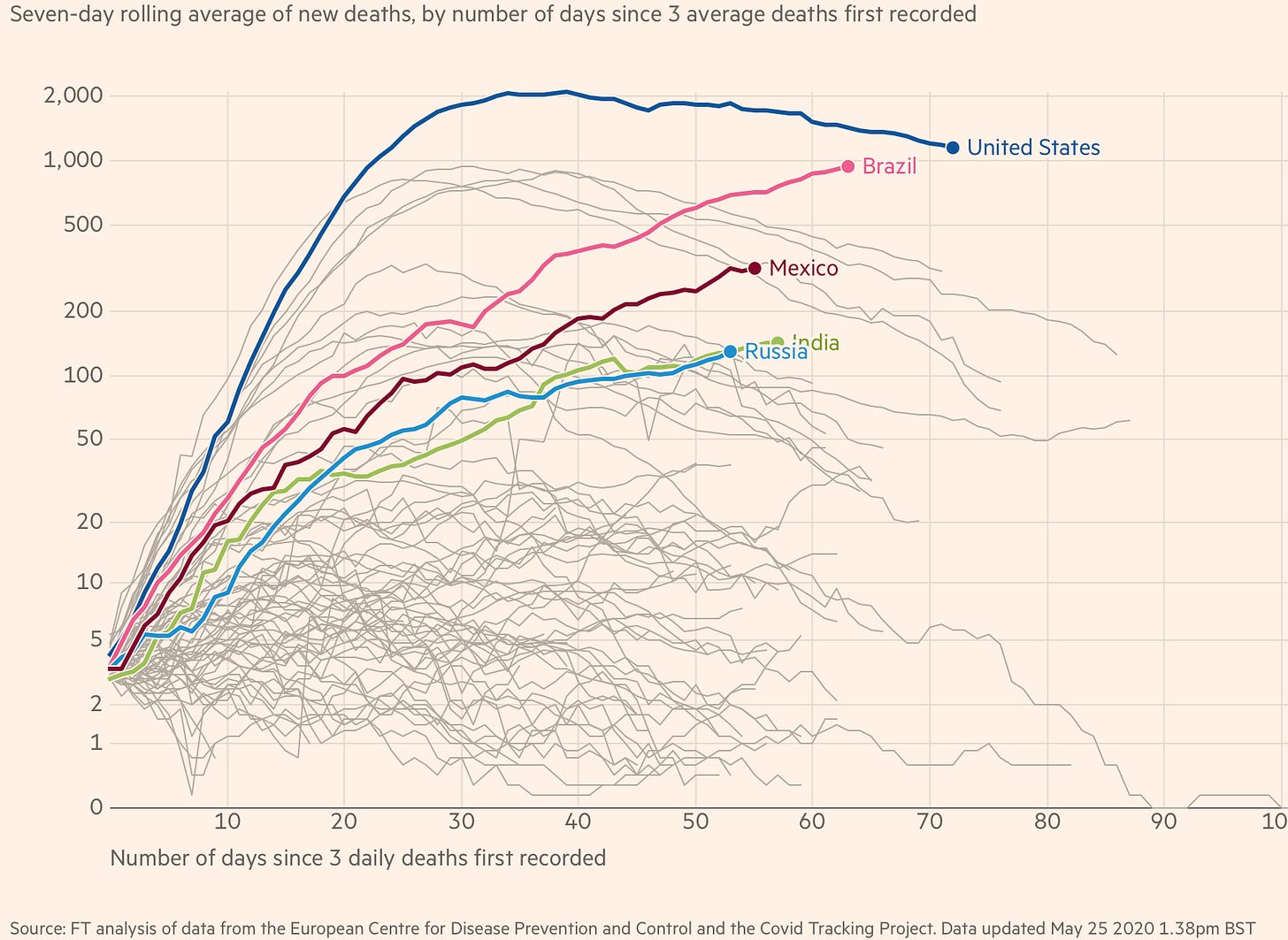
2) U.S. states reopening risk map: this analysis includes current estimated R (reproduction number) for each state (Link) (NEW❗️4th indicator added)
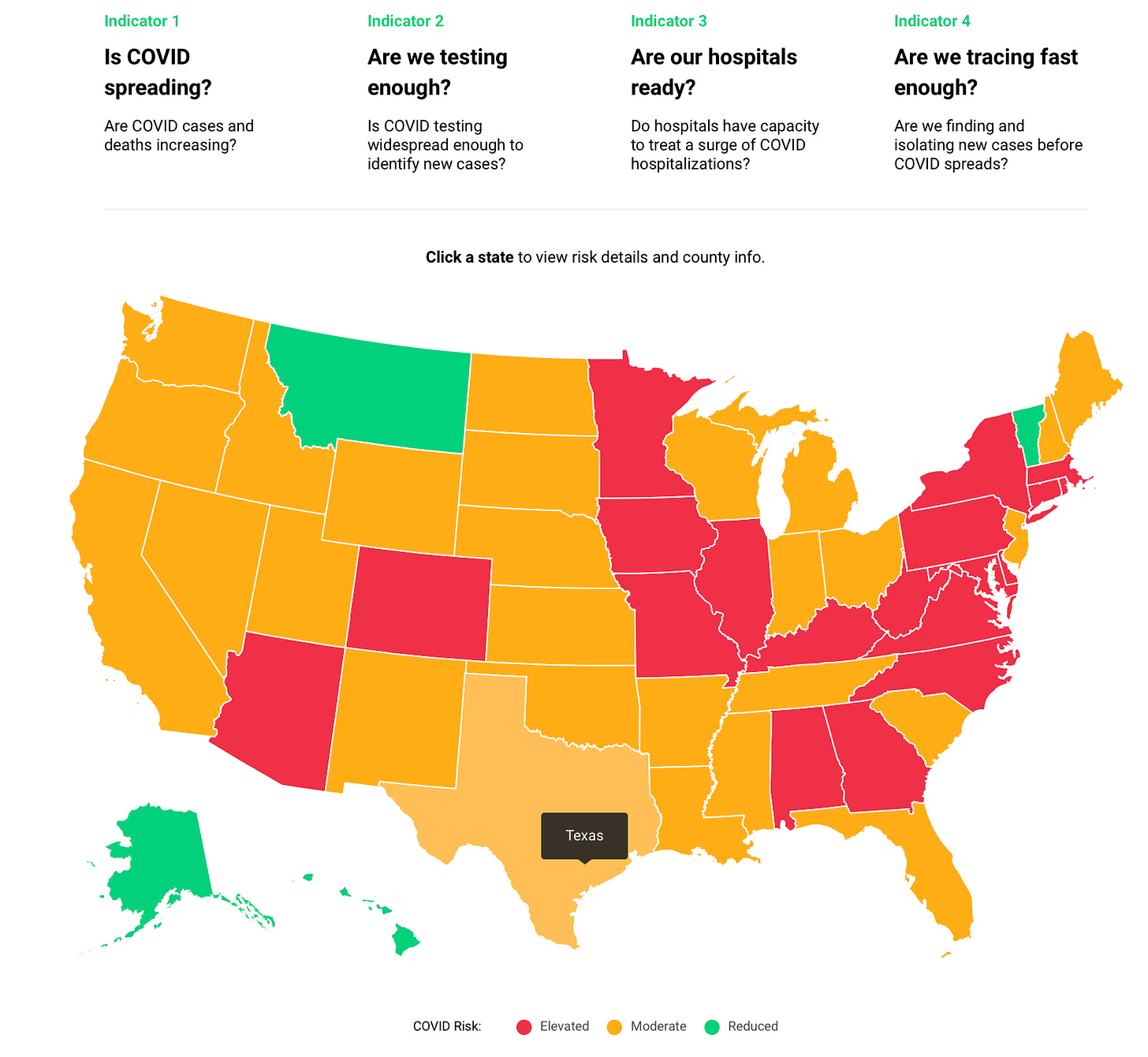
3) Rt estimate per country (NEW❗️). This is a new resource link in the data section from a team which has led accuracy in modelling fatalities in the US for the past few weeks. (Link)

It can be quite disheartening to see all the sacrifices which the public has made not being met by honesty, appreciation. competence and compassion amongst the elected (or non elected) government official in some countries. Nothing more than the Dominic Cummings controversy in the U.K. exemplifies this disconnect. It is a mix of arrogance and contempt of the public, which the Corona Daily had highlighted early on March 15 in an edition titled “Underestimating the public”.
However what the public and science has achieved in such a short period of time needs celebrating and this is what the Editorial Board at the New York Times decided to do. There is also a related and shrewd article on the inappropriateness of framing this pandemic as a ‘war’ and it constraining the ability of the public to think and invent a better future. When it comes to science Megan Ranney outlines how much we have learned but also what still needs to be discovered.
A current and former US official are optimistic about the US winning the vaccine race in today’s Video of the Day. Sharing globally is reassuringly mentioned as well.
I then look at the underreported but successful “Japan Model” and some of the recent research focusing on identifying the problematic clusters in SARS-CoV-2 transmission which underpin it.
Erika Christakis writes an important and in-depth article on the future of schools post-pandemic.
The Corona Daily finally highlights the tragic setback for 80 million children around the world on vaccination (such as measles, polio, and other vaccine preventable diseases).
Two great podcasts on digital disease surveillance and privacy.
NEW❗️I have open-sourced the articles feeds I curate the Corona Daily from and made them freely available below. The feeds included are listed here.
🇺🇸 Article of the day: the editorial board writes “Keep Up the Good Work, America” for the New York Times (Link)
This is a great article. At times the reporting has been brutal in the U.S. lambasting the Federal response, and maybe depressing for the public. In this editorial, the New York Times looks at all the ways in which the public has risen to the challenge posed by the pandemic, whilst still highlighting the weaknesses which it has exposed and which will require America to rise again to successfully challenge them.
💉 Video of the day: Robert O’Brien (U.S. National Security advisor) and Scott Gottlieb (former director Food and Drug Administration) talk COVID-19 vaccine. They cover espionage allegations against China, why the US will likely get there first based on preliminary recent results from China. The latter is using rather antiquated technology relative to some of the more novel platforms U.S. companies are leading with in their vaccine efforts. O’Brien also shares reassuringly the intention of the U.S. to share its success with the world. (Link)

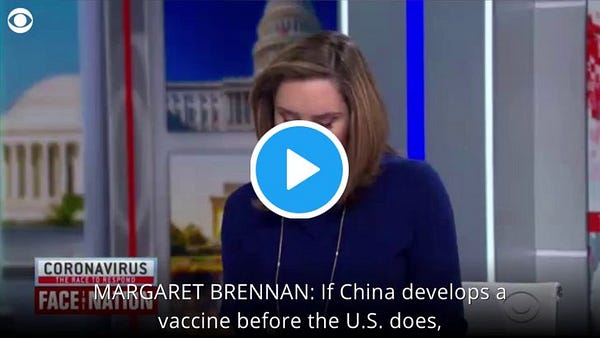
🦠Thread of the day (MUST READ): The knowns and known unknowns by Megan Ranney (Associate Professor of Emergency Medicine at Brown University) (Twitter thread). Fantastic and well-referenced thread about state of knowledge on COVID-19.
💊 Tweet of the day: expected but significant news announcements on the back of the large Lancet study reported in the previous Corona Daily: WHO is pausing trial on chloroquine/hydroxychloroquine.

🆙 Hanna Meretoja writes “Stop narrating the pandemic as a story of war” for Open Democracy. Meretoja writes a shrewd article on why narrating the pandemic as a war is both inappropriate and even more importantly frames it in a way which limits the renewal and thinking which COVID-19 should ignite.
“The future of humankind depends on the path we decide to take, and that path largely depends on how we narrate the pandemic and the lessons to be drawn from it as we move forward. Let’s make sure these narratives hold open the possibility we now have to leave behind an unsustainable way of life and to imagine a world based on solidarity and care.”
(Link)
🇯🇵 Lisa Du and Grace Huang write “Did Japan Just Beat the Virus Without Lockdowns or Mass Testing?” for Bloomberg. It was followed today by an article in the Financial Times “Japan model’ has beaten coronavirus, Shinzo Abe declares”.
All eyes have been on Sweden and South Korea, but Japan has been the quiet successful one.
Its success rests on three pillars: clear communication and awareness (in part due to the controversy surrounding the Diamond Princess cruise ship “fiasco” early on in the pandemic), robust tracing and selected testing, and ubiquitous mask wearing.
The clarity of messaging to the public around the “Three Cs” is particularly noteworthy. Its aims was to contain the most dangerous infection clusters:
It is in sharp contrast, with the confusion which has surrounded the U.K. messaging, needing at times clarification statements (“Downing Street clarifies Boris Johnson’s comments about seeing his mum on Mother’s Day)”, using ambiguous slogans (“UK PM Boris Johnson’s new ‘stay alert’ coronavirus warning criticized as ‘confused’ and ‘nonsensical’” and now with Dominic Cummings being supported for using his ‘instinct’ instead of following the national guidelines (“Boris Johnson: Dominic Cummings followed 'instincts of every father' in lockdown”). Japanese rigor and discipline versus English exceptionalism and humbug.
The leadership of Japan was shown publicly wearing masks to incentivise their citizens to do the same:

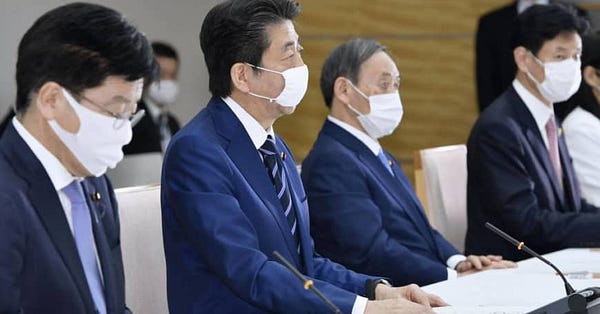
It should be noted that there might be other and unknown factors at play in the current success of Japan some favourable (low obesity rate amongst population) and some negative (one of the oldest population). However, other countries should study and learn from it. (Link and great Twitter Thread)
🦠 The Corona Daily had previously reported the excellent article from Kai Kupferschmidt on the dispersion factor k of SARS-CoV-2 and cited one of the pre-print highlighted by Eric Topol in a Twitter Thread yesterday.
This topic and area of investigation is increasingly going to come into focus as more economies re-open:


It is early days, but the two recent articles from Israel and Hong Kong sketch both a policy route and research area to help contain the pandemic going forward by focusing in particular on “indoor setting” and specific events.
This thinking appears to have been core to the “Japan model” outlined above. Early days but promising path. (Twitter thread)
🏫 Erika Christakis (Early childhood educator) writes “For Schools, the List of Obstacles Grows and Grows” for The Atlantic. As an early childhood educator, Christakis has an in-depth comprehension of what learning entails and it transpires throughout the article.
She sees the pandemic as an opportunity to rethink schooling, whilst exhaustively outlining the obstacles which will need to be overcome to reach a better place for children. She identifies four principles to guide this schooling renewal:
“When children do return, K–12 schools and child-care programs should be guided by four core principles: knowledge of child development and all its variation; prioritization of the youngest and most vulnerable students; flexibility for families and teaching staff; and a shared sense of purpose and duty.”
An important read. (Link)
🧒 “At least 80 million children under one at risk of diseases such as diphtheria, measles and polio as COVID-19 disrupts routine vaccination efforts, warn Gavi, WHO and UNICEF”. Following this warning, Andrew Joseph reported on the issue for STAT news. This is a sad and significant disruption from the COVID-19 pandemic, showing if needed how little spare capacity world public health historically had.
“The agencies said that the disruptions are occurring at a scale unseen since widespread immunization campaigns began in the 1970s.”
It is hard for now to measure the human life costs of this disruption. (Link)
🎙 Podcasts
🦠 The Andreesen Horowitz podcast: “Pandemics: Early Detection, Networks, Spreaders” with NA Christakis and Jorge Conde (Link)
“Going from rapid warning to early detection through social network sensors can make all the difference when it comes to contagion/ the spread of disease and pandemics. Can we get public health bio surveillance without sacrificing privacy and agency?”
🚔 Centre for European Policy Studies (CEPS) organised the webinar “COVID-19 and The Use of Electronic Data: Trust, Privacy and the Rule of Law” with Vera Jourova (Vice-President for Values and Transparency in the EuropeanCommission) (Link)
📊 A picture is worth a thousand words: Global (🌎) and local (with relevant flag) visualisation and forecasting tool
🦠 “Science Forum: SARS-CoV-2 (COVID-19) by the numbers” (Link)
“The COVID-19 pandemic is a harsh reminder of the fact that, whether in a single human host or a wave of infection across continents, viral dynamics is often a story about the numbers. In this article we provide a one-stop, curated graphical source for the key numbers (based mostly on the peer-reviewed literature) about the SARS-CoV-2 virus that is responsible for the pandemic. The discussion is framed around two broad themes: i) the biology of the virus itself; ii) the characteristics of the infection of a single human host.”
🇺🇸🌎
NEW❗️This model has led accuracy for several weeks in the US. It also does projection for Europe and Rest of the World. (Link)🇺🇸 “Is your community ready to reopen?”: A map of the US (50 states and 2,100+ counties) looking at reopening risks with metrics around 3 criteria: 1. Is COVID in retreat? 2. Are we testing enough? 3. Are our hospitals ready? (Link)
🌎The Financial Times (visualisation) has a data tracking page which is in front of the paywall, looking at cases and fatality curves for selective countries and metropolitan areas/region. It is not as extensive as the Madlag link below, where you can see static as well as animated images for a greater number of individual countries. (Link)🇺🇸 The Johns Hopkins University resource center was the first one I used back in January they have now made available in their latest iteration a county by county dashboard in the US including information about health capacity, insurance coverage, ethnicity and age breakdown of the populatio (Link)
💊 The "Map of Hope" provides a geographical overview of planned, ongoing and completed clinical trials. It is put together with data from WHO Clinical Trials Search Portal by the Heidelberg Institute for Geoinformation technology. (Link)
🌍 MRC Centre for Global Infectious Disease Analysis started to publish weekly death estimates for countries (Link)
🇺🇸 The US Center for Disease Control and Surveillance (CDC) publishes “A Weekly Surveillance Summary of U.S. COVID-19 Activity” (Link)
Google has published a new website to “See how your community is moving around differently due to COVID-19”. They have a lot of data to do so… (Link)
🌎 Country by Country Curves: This is a GitHub made by my friend Francois Lagunas. He has written a script to scrape deaths and number of cases in order to visualise the rate of growth on a logarithmic scale. Great resource (Link)






